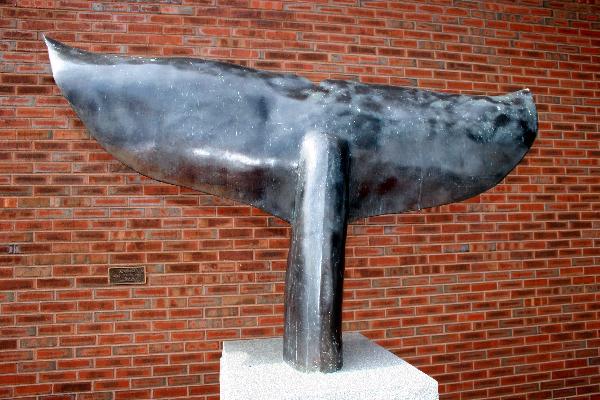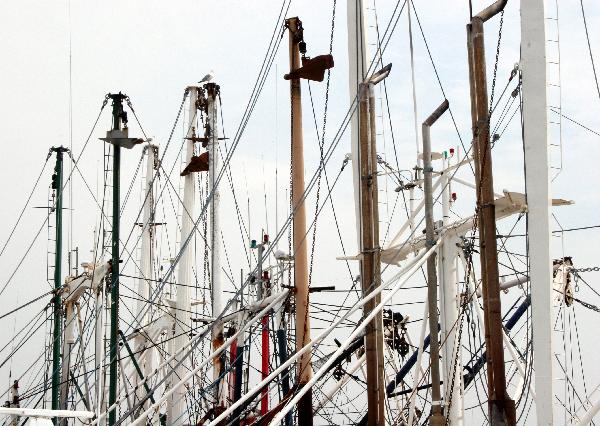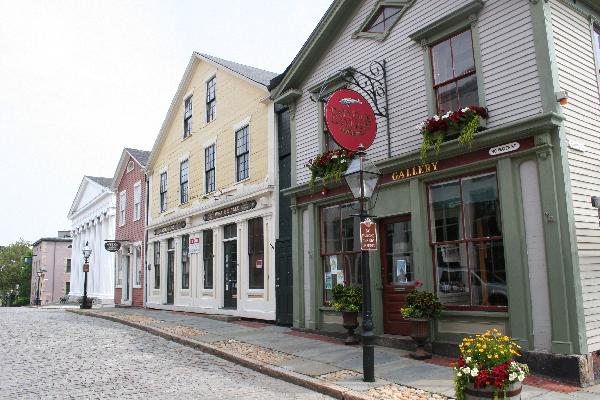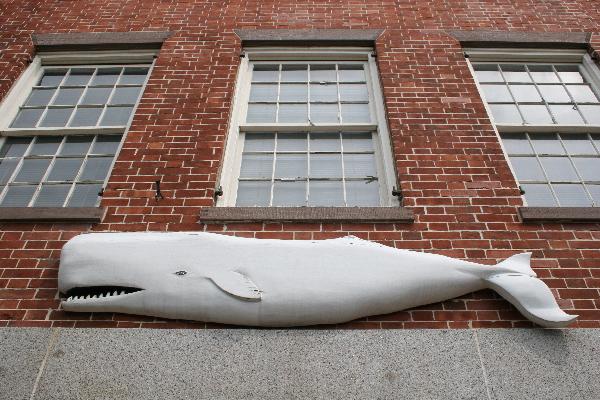NPS Website; Local Website; New Bedford Whaling Museum Website
 WHAT IS IT?
WHAT IS IT?13 block of New Bedford's cobblestone streets, restored 19th Century buildings and active port and harbor. The Site honors the town's storied whaling industry history through affiliations with private Museums, businesses and churches.
BEAUTY (4/10)
The Park's few square blocks contain quaint, sturdy New England-ish buildings, two imposing neo-classical designs, the U.S. Custom House and the Double Bank Building, and a busy stretch of working harbor. The cobblestone streets, whose bumpiness ably keeps out through traffic, are lined with floral arrangements and surprisingly large front lawns.
The Park's two most astounding sights are inside the Whaling Museum. A 66-foot long blue whale skeleton hangs in the Museum's courtyard and the world's largest ship model, a 1/3-scale replica of a whaling ship is sequestered in the Museum's second floor. If you wish to view the ship, you need to pay the Museum's entry fee; gasping at the skeleton, on the other hand, costs nothing.
HISTORICAL INTEREST (4/10)
The Park's brochure hails New Bedford as the “Whaling Capital of the World”. Nantucket Island might dispute this statement. Nonetheless, we are glad the National Park Service located its whaling history Site here and not a seasonal ferry boat ride away. New Bedford's lasting whale legacy owes equally to the 100-year old New Bedford Whaling Museum (affiliated with the Park) and Herman Melville's Moby Dick, whose opening 13 chapters are set in these very streets.
 CROWDS (8/10)
CROWDS (8/10)New Bedford residents are so shocked to see tourists in their industrial town that they react with effusive and inquisitive kindness. In 2004, two separate strangers approached us offering suggestions on where to eat and where to go.
In 2006, an incredulous boat captain, just back from a long commercial fishing haul, wondered why we would choose to vacation here at a working waterfront. “Are you guys from the local paper,” he wondered. After we said no, he explained his job and the role of the commercial fisherman for about ten minutes. We could not have asked for a better lesson. He is the modern-day equivalent of the New Bedford whaler that the Park honors.
Regardless, he was still unsure as to why we were here. Our explanations were insufficient. We were not the only ones. His “When I'm done working, I try to get out of here as soon as possible” comment was betrayed by the two cases of beer he was carrying to his boat as well as the impatient, thirsty faces of his deck hands.
EASE OF USE/ACCESS (3/5)
Head for downtown New Bedford. Take Interstate 195 Exit 15 and head south for about one mile along Massachusetts Route 18. Turn right at Elm Street and then left into the cobblestone streets. The Park suggests the Elm Street Parking garage. We do not because the Park offers no validation. There is, however, free two-hour parking located on Bethel Street/Johnny Cake Hill next to the Whaling Museum. Park there. If spots are limited, street parking is only $0.25 per hour. Skip the garage.
The Park's accessibility is severely hampered by the fact that many of its buildings are privately run and not open to the public. Since there are so many establishments (private, fee and free) that fall under the New Bedford Whaling NHP umbrella, it is difficult to ascertain both which ones you should be looking at and what exactly you should do. The Park's multiple maps and brochures help focus your visit but also overwhelm.
Our suggestion is to begin your visit at the Park Visitor Center located at the corner of Second and William. Pick up the Herman Melville New Bedford walking tour brochure, wander the streets with that guide and then spend the remainder of your stay at the Whaling Museum.
 CONCESSIONS/BOOKSTORE (5/5)
CONCESSIONS/BOOKSTORE (5/5)While the Park VC may stock a manageable array of gifts (we love the Melville dolls) skip it and head straight to the Whaling Museum for your shopping needs. Don't worry about fees, you do not need to buy a Museum ticket to enter its bookstore.
Wow, what a selection. The stores sells over ten different editions of Moby Dick. We prefer the Norton Critical Edition. And that's just the start of the whale tales; the store's total nautical yarns might break four digits. If your looking for a more tangible whaling memory, there is gorgeous carved scrimshaw and other intricately adorned leviathan likenesses.
COSTS (1/5)
New Bedford Whaling NHP's marquee stop is the Whaling Museum, located on Johnny Cake Hill. It costs $10 per person, no National Parks Pass discount, although AAA will help a bit. The Museum existed for 90 years before the National Park Service arrived in 1996. We do not like paying for museums, living in Washington DC spoiled Michael, but there is no point in coming to New Bedford if you skip the Whaling Museum.
Across the street from the Museum is Seamen's Bethel Church, the town's other can't miss attraction. Moby Dick's portentous “Jonah and the whale” sermon occurred here. Non-readers will notice that the church's pulpit is the same one used by Orson Welles in the cinematic retelling of Melville's classic.
RANGER/GUIDE TO TOURIST RATIO (1/5)
Two trips to New Bedford, zero Rangers seen. We twice waited patiently for the 10:30 am Ranger-led walking tour but no one showed up either time.
TOURS/CLASSES (4/10)
The Site does not hurt for educational options. You might need an extra bag to carry all of the Park's provided literature. There are modest exhibits at its two Visitor Centers, three themed walking trail brochures (Herman Melville's New Bedford; the Underground Railroad; and the Working Waterfront Dock Walk) and a free 20-minute movie shown in the Whaling Museum's ornate theater.
All these options are free albeit in-depth, a little dry and attention intensive. The Whaling Museum, while not free and not NPS run, is spectacular.
 FUN (7/10)
FUN (7/10)Moby Dick is Michael’s favorite novel. The book starts out in New Bedford. The first few times he read it, he was eager to get through the first few chapters, out of the city, onto the sea and into adventure. After our first visit, this is how we felt about New Bedford Whaling NHP.
During Michael's last reading of Moby Dick, while we were camping in the solitude of Channel Islands NP, he paid closer attention to the book's opening chapters. Pages that had been an annoying means to an eventual end this time emitted wry humor that was part satire part ribald slapstick. The book's early pages now teemed with rewarding moments. Michael was still ready to search for the white whale but he appreciated the goofy charm of an underappreciated town.
WOULD WE RECOMMEND? (3/10)
Was Melville right when he told visitors to believe that New Bedford has more to offer than “harpooners, cannibals and bumpkins?” Yes, it has a Whaling Museum. Er...that's fits the harpooners category. On the plus side, we saw neither cannibals nor bumpkins.
If whaling history and Melville are your thing, you have probably already been to New Bedford. We cannot come up with a good reason for a neophyte whaling enthusiast or somebody without anti-transcendentalist interests to come here. The cobblestone streets and historic buildings are similar to many other New England coastal towns and no whale watching excursions leave from this port.
TOTAL 40/80
www.usa-c2c.com
© 2004-06